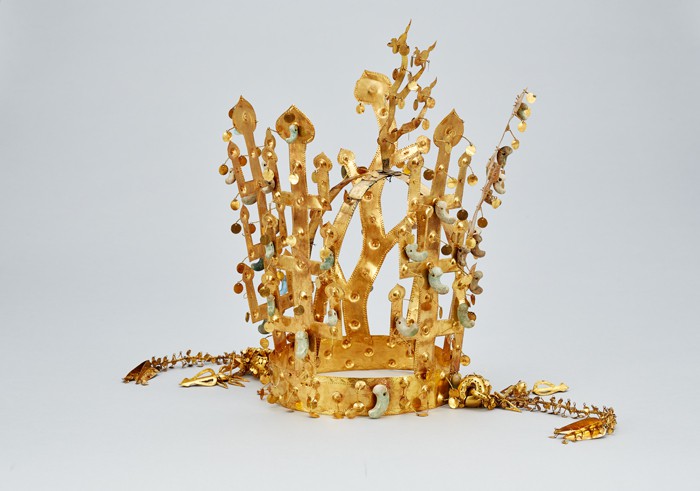A gold crown decorated with three phoenixes was excavated in the Noseo-dong neighborhood of Gyeongju, Gyeongsangbuk-do (North Gyeongsang Province), in 1926. At the time, Swedish Crown Prince Gustav Adolf the Sixth was visiting Korea on his honeymoon. It was he who picked up a golden belt at the excavation site and since that time the tomb has been called the Seobongchong Tomb (서봉총, 瑞鳳塚), combining the words seo for, “Sweden” (스웨덴, 瑞典), and bong for, “phoenix” (봉황, 鳳凰).
The artifacts found in the Seobongchong Tomb are now on display at the National Museum of Korea in central Seoul. The artifacts include the gold crown with a decoration of three phoenixes, the golden belt with ornaments and pendants as well as gold earrings and a silver bowl with an inscription.
The museum’s “New Scientific Revelations About the Gold Crown From the Seobongchong Tomb” exhibit shows the fact that the crown was mended at some point in the 20th century and gives a detailed explanation of the artifacts after years of scientific analysis.

A gold crown, an ornamental gold belt with pendants and gold earrings found in the Seobongchong Tomb in Gyeongju are on display at the National Museum in Seoul.

The gold crown with a three-phoenix decoration is currently on display at the National Museum of Korea. It was excavated from the Seobongchong Tomb in 1926.
A total of six gold crowns from the Silla Kingdom (57 B.C.-A.D. 668) have since been found, and all of them were produced between the 5th and early 6th centuries. Only one of them — that found in the Seobongchong Tomb — has phoenix decorations.
The crown is made up of 374 components, including 320 pieces of gold. Plates, nails and thread are made of gold, too, while curved beads are made of jade or glass.
To learn more about the artifacts, archeologists and researchers at the museum used X-ray fluorescence (XRF) and tested the purity of each of the crown’s golden components. They discovered that the golden thread used to make the crown had different production dates. Most of the thread used to tighten the beads decorating the round plate edge of the crown was made of 17-karat gold when it was first produced during the Silla period. However, some of the thread was found to be between 23 and 24 karats, which indicates that these elements were made of pure gold. This shows that the crown was repaired at some points after it was dug out from the ancient tomb.

Gold thread (left) is made with a traditional ‘pulling’ technique during the Silla period, while thread used in later repairs is made of pure gold.


Gold belt ornaments and pendants (top) and gold earrings are currently on display at the National Museum of Korea in Seoul.
In addition to the crown, archaeologists have found a silver bowl with an inscription. The inscription is located inside the dish and on the bottom of the bowl. It gives some clues as to the timeline of the Seobongchong Tomb. The sinmyonyeon inscribed inside the bowl indicates that it was made either in the year 451 or 511.
The exhibition also has two Western glass bowls that are believed to have come from Europe or Persia along the Silk Road.

A silver bowl with an inner inscription can be seen at the National Museum.
The exhibit will continue until June 21. Entrance is free. For more information, please visit the museum’s homepage (http://www.museum.go.kr/site/main/index002).
By Limb Jae-un
Korea.net Staff Writer
Photos courtesy of the National Museum of Korea
jun2@korea.kr






![[102nd March First Independence Movement Day] American journalist’s Seoul home to be opened to public](https://gangnam.com/file/2021/03/usr_1614255694426-218x150.jpg)
















